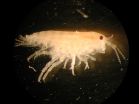(Press-News.org) A new study led by a Canadian marine zoologist reviews the world list of specialist driftwood talitrids, which so far comprises a total of 7 representatives, including two newly described species. These tiny animals with peculiar habits all live in and feed on decomposing marine driftwood. Dispersed across distant oceanic islands they use floating driftwood to hitch a ride to their destination. The study was published in the open access journal Zoosystematics and Evolution.
Tourists are familiar with talitrids as sandhoppers, found in burrows on sand beaches, or shorehoppers, which are non-burrowers associated with wrack thrown up by the high tide. But they probably do not suspect the existence of an additional ecological group of marine talitrids, which are obligately associated, both for food and shelter, with driftwood.
These tiny animals just like tourists have travelled a long way to reach their destination. They travel on floating driftwood logs, which serve them both as a means of transportation and as a food source.
"Specialist driftwood talitrids are rare and difficult to study group because of their small size and cryptozoic habitat. Only seven species are presently known in the world list, but this is almost certainly because of inadequate searching in the right places."comments the author of the study Dr. Dave Wildish, "Fisheries and Oceans Canada".
Driftwood is common at higher latitudes in the driftline of both northern and southern hemispheres, although all seven species recorded so far are from the northern hemisphere.
A characteristic feature of specialist driftwood talitrids is their small size (less than 15mm body length, technically termed "dwarfism"). One species which as an adult is less 8mm in body length is one of the smallest talitrids known.
Dwarfism in specialist driftwood talitrids is achieved by a form of "neoteny". This means that adults retain juvenile features but become sexually mature at an early stage in development. Neotenous development in driftwood talitrids involves: fewer moults per life cycle, sexualisation beginning at an earlier moult number, and the size increment at each moult remaining the same.
This adaptation is key to specialist driftwood talitrids because it allows the hitchhiker to live within the floating driftwood and thereby the possibility of a much longer ride to a new home. Passive dispersal on other media, such as wrack, can be short-lived due to break up of the floating wrack. Passive dispersal to distant places is made possible by the driftwood talitrid hitching a ride on the floating driftwood log; a process which could take these little travellers a considerable amount of time.
INFORMATION:
Original Source
Wildish D (2014) New genus and two new species of driftwood hoppers (Crustacea, Amphipoda, Talitridae) from northeast Atlantic and Mediterranean coastal regions. Zoosystematics and Evolution 90(2): 133-146. doi: 10.3897/zse.90.8410
Additional Information
Wildish, D.J. 1972.Post embryonic growth and age in some littoral Orchestia (Amphipoda, Talitridae). Crustaceana Supplement 3: 267-274.
Wildish, D. J. 2012. Long distance dispersal and evolution of talitrids (Crustacea: Amphipoda: Talitridae) in the northeast Atlantic islands. Journal of Natural History 46: 2329-2348.
Wildish, D. J., Pavesi, L and Ketmaier, V. 2012. Talitrid amphipods (Crustacea: Amphipoda: Talitridae) and the driftwood ecological niche: a morphological and molecular study. Journal of Natural History 46: 2677-2700.
Pavesi, L, Wildish, D.J, Gasson,P, Lowe, M and Ketmaier, V. 2014. Further morphological and molecular studies of driftwood hoppers (Crustacea: Amphipoda: Talitridae) from Mediterranean/Northeast Atlantic coastlines. Journal of Natural History. In press.
New clinical research from UC San Francisco shows that 341 HIV-infected men who reported using stimulants such as methamphetamine or cocaine derived life-saving benefits from being on antiretroviral therapy that were comparable to those of HIV-infected men who do not use stimulants.
That said, those who reported using stimulants at more than half of at least two study visits did have modestly increased chances of progressing to AIDS or dying after starting antiretroviral therapy compared to non-users. The data was collected between 1996 and 2012.
"Patients with HIV ...
PHILADELPHIA –The pneumococcal vaccine recommended for young children not only prevents illness and death, but also has dramatically reduced severe antibiotic-resistant infections, suggests nationwide research being presented at IDWeek 2014™. Pneumococcal infection – which can cause everything from ear infections to pneumonia and meningitis – is the most common vaccine-preventable bacterial cause of death.
The 13-valent pneumococcal conjugate vaccine (PCV13), first available in 2010 (replacing 7-valent pneumococcal conjugate vaccine, PCV7), reduced the ...
PHILADELPHIA – Old-school face-to-face social networking is a more effective way to identify people with HIV than the traditional referral method, suggests research being presented at IDWeek 2014™. The study shows that social networking strategies (SNS) – enlisting people in high-risk groups to recruit their peers to get tested – is more efficient and targeted than traditional testing and referral programs, resulting in 2-1/2 times more positive test results.
As many as 20 percent of HIV-positive people are unaware of being infected with the virus, ...
The experiments were carried out on endofullerenes, molecules of C60 into which smaller molecules of Hydrogen (H2) had been inserted. The results, published in Physical Review Letters, represent the first known example of a quantum selection rule found in a molecule.
Similar techniques were also used by the same team to uncover an exciting new symmetry-breaking interaction of water molecules with C60 cages, published last month in Physical Chemistry Chemical Physics.
The use of fullerenes such as C60 to trap smaller molecules, using cutting-edge molecular surgery techniques, ...
This news release is available in German.
The distance between the Earth and the Sun has no influence on the decay rate of radioactive chlorine. You could ask: "And why should it anyway?", because it is well known that the decay of radionuclides is as reliable as a Swiss clock. Recently, US-American scientists, however, attracted attention when they postulated that the decay rate depends on the flow of solar neutrinos and, thus, also on the distance from the Earth to the Sun. Their assumption was based, among other things, on older measurement data of the Physikalisch-Technische ...
WASHINGTON, DC – OCTOBER 10, 2014 - Mineral coatings on sand particles actually encourage microbial activity in the rapid sand filters that are used to treat groundwater for drinking, according to a paper published ahead of print in Applied and Environmental Microbiology. These findings resoundingly refute, for the first time, the conventional wisdom that the mineral deposits interfere with microbial colonization of the sand particles.
"We find an overwhelmingly positive effect of mineral deposits on microbial activity and density," says corresponding author Barth ...
A study on the global burden of venous thromboembolism—when a dangerous clot forms in a blood vessel—found that annual incidences range from 0.75 to 2.69 per 1,000 individuals in the population. The incidence increased to between 2 and 7 per 1,000 among those 70 years of age or more.
"Venous thromboembolism in hospitalized patients was responsible for more years lost due to ill-health than hospital-acquired pneumonia, catheter-related blood stream infections, and side effects from drugs," said Dr. Gary Raskob, co-author of the Journal of Thrombosis & Haemostasis ...
Philadelphia, PA, October 9, 2014 – Researchers at Sanford-Burnham Medical Research Institute have identified a set of RNA molecules that are detectable in tissue samples and urine of prostate cancer patients but not in normal healthy individuals. The study sets the stage for the development of more sensitive and specific noninvasive tests for prostate cancer than those currently available, which could result in fewer unnecessary prostate biopsies with less treatment-related morbidity, according to a new study in The Journal of Molecular Diagnostics.
According to ...
Stanford engineers have invented a wireless pressure sensor that has already been used to measure brain pressure in lab mice with brain injuries.
The underlying technology has such broad potential that it could one day be used to create skin-like materials that can sense pressure, leading to prosthetic devices with the electronic equivalent of a sense of touch.
A nine-member research team led by Chemical Engineering Professor Zhenan Bao detailed two medical applications of this technology in Nature Communications.
In one simple demonstration they used this wireless ...
Researchers from the University of Melbourne have established how two diseases that present in similar ways are in fact quite different.
Progressive Supranuclear palsy and Parkinson's Disease have overlapping symptoms but remain difficult to distinguish.
However, a first ever paper on the topic published in the Journal of Neuropsychology (British Psychological Society publication) now suggests that people with PSP experience more severe and extensive cognitive impairments than those with PD early on.
The study indicates that patients with PSP experience more severe ...


